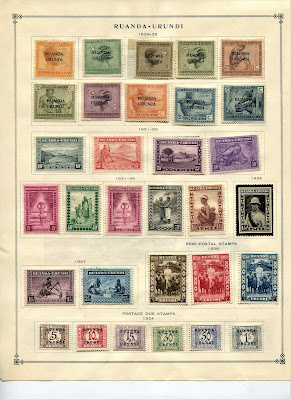Belgium gained governing control over Ruanda /Urundi,
now renamed Rwanda and Burundi, in 1918 under the Treaty of Versailles.
Germany, defeated in World War I, lost its control of German East Africa, the
western part of which was given to Belgium. Neither Germany nor Belgium had
much knowledge or insight about the people living there but, because the
territory bordered on Belgian Congo and none of the other victorious Allies
particularly wanted it, Ruanda/Urundi passed to Belgium.
Not until 1924 was the first postage issued, all
repurposed stamps of the 1923 Belgian Congo series. These overprints continued
in use until 1931, Scott numbers 6 through 36. For some reason, a lower case
“i” is used in the spelling of “URUNDi.
Scott numbers 1 through 5 no longer appear in the Scott’s
Ruanda /Urundi listings. Being wartime occupation stamps, they were shifted to
Scott’s section for German East Africa and identified as n25 – n29.
In precolonial times the
population of Ruanda/Urundi was comprised mainly of the Bantu-speaking Hutu and
Tutsi tribes (the latter being known to Europeans as Batutsi or Watusi). Society
was organized in a feudal system with the Tutsis as chiefs and Hutus as
workers. The lines between the two groups were porous. People could intermarry
and move back-and-forth socially. Those identifying as Hutu outnumbered the
Tutsi six to one. An additional very small minority identified as Twa, a
marginalized pygmy people.
The Germans and Belgians
turned this traditional arrangement into a rigid race-based class system, using
now discredited European theories of race as justification. Tribal identity was
fixed at birth and remained that way throughout life. Moreover, the Belgians
favored the Tutsi over the Hutus, giving them European-style education and
privileges of power. In 1926, the Belgians introduced separate ethnic identity
cards (indangamuntu) for the Tutsi and Hutu to carry, a policy that
helped the Tutsi enforce Belgian control.
This hardline
classification provoked the tensions that led, in great part, to genocide in
the 1990s. During and after the genocide the cards were used to identify
victims; most were Tutsi. The card, originally signifying entitlement to power,
became a passport to death.
A Tutsi identified.
Does anything in the
early stamps of Rwanda/Urundi, I wonder, predict the ensuing horrors of the genocide?
In 1931 Belgium issued the first stamps with “Ruanda/Urundi” inscribed. The artwork
features native people in a variety of settings. Although the tribal identity
of the subjects is not mentioned on these stamps, Tutsis likely posed for the
original artwork (or were imagined by the artists). The resulting images
conform to the European racial biases of the time – tall body, narrow nose,
slender face, etc. Belgium chose their favored subjects for colonial stamp
designs.
Scott # 54 brown, 52 gray, and 53 brown violet
Otherwise, I find no
philatelic hints about the underlying conditions that led to genocide.
The late 1990s the genocide
eventually spent its anger and, in more recent years, Tutsis and Hutus are
learning to live together again.
Census: in BB spaces 31, on supplement pages 38. Catalog values for mint and used stamps are basically the same.











No comments:
Post a Comment